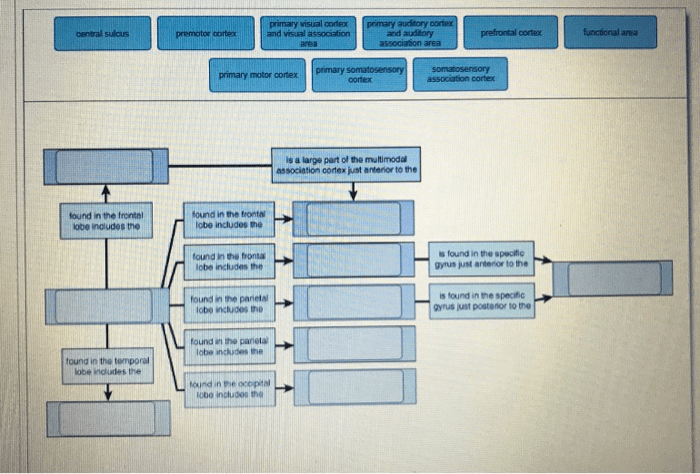Concept map functional areas of the cerebrum – The concept map of the functional areas of the cerebrum provides a comprehensive overview of the diverse regions within the brain responsible for our cognitive abilities. Each area possesses specialized functions that contribute to our perception, cognition, and behavior, working in harmony to orchestrate the complex processes that define our human experience.
The frontal lobe, parietal lobe, temporal lobe, and occipital lobe each play distinct roles in processing information, from sensory input to higher-order cognitive functions. Understanding these functional areas and their integration is crucial for unraveling the intricate workings of the human brain.
Functional Areas of the Cerebrum: Concept Map Functional Areas Of The Cerebrum

The cerebrum, the largest part of the brain, is responsible for higher-order cognitive functions such as thinking, planning, and language. It is divided into two hemispheres, each of which contains specific functional areas.
Frontal Lobe
The frontal lobe is located at the front of the brain and is responsible for:
- Higher-order cognitive processes, such as planning, decision-making, and problem-solving
- Language production and comprehension
- Motor control
- Personality and social behavior
Parietal Lobe
The parietal lobe is located at the top of the brain and is responsible for:
- Processing sensory information, such as touch, temperature, and spatial awareness
- Integrating sensory information from different modalities
- Attention and working memory
Temporal Lobe
The temporal lobe is located at the side of the brain and is responsible for:
- Processing auditory information
- Memory formation and retrieval
- Language comprehension
- Emotion and social behavior
Occipital Lobe, Concept map functional areas of the cerebrum
The occipital lobe is located at the back of the brain and is responsible for:
- Processing visual information
- Recognizing objects and faces
- Spatial navigation
Integration of Functional Areas
The different functional areas of the cerebrum work together to support cognitive functions. For example, the frontal lobe is responsible for planning and decision-making, while the parietal lobe processes sensory information. The temporal lobe is responsible for memory and language comprehension, while the occipital lobe processes visual information.
These areas work together to allow us to interact with our environment and make sense of the world around us.
Clinical Implications
Damage to specific functional areas of the cerebrum can affect cognitive abilities. For example, damage to the frontal lobe can lead to problems with planning, decision-making, and language production. Damage to the parietal lobe can lead to problems with sensory processing and spatial awareness.
Damage to the temporal lobe can lead to problems with memory and language comprehension. Damage to the occipital lobe can lead to problems with vision.
FAQs
What are the primary functional areas of the cerebrum?
The primary functional areas of the cerebrum include the frontal lobe, parietal lobe, temporal lobe, and occipital lobe, each with specialized functions related to cognition, sensory processing, and motor control.
How do the functional areas of the cerebrum work together?
The functional areas of the cerebrum are interconnected and work in an integrated manner. For example, the frontal lobe is involved in planning and decision-making, while the parietal lobe processes sensory information. These areas collaborate to support complex cognitive functions such as attention, memory, and language.
What are the clinical implications of damage to specific functional areas of the cerebrum?
Damage to specific functional areas of the cerebrum can lead to a range of cognitive deficits. For instance, damage to the frontal lobe can impair executive functions such as planning and decision-making, while damage to the temporal lobe can affect memory and language comprehension.

